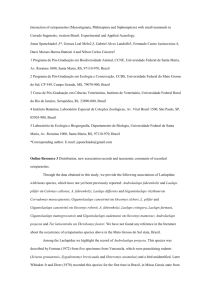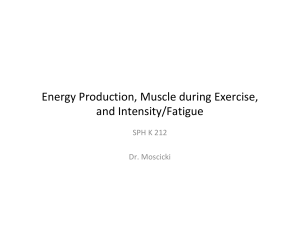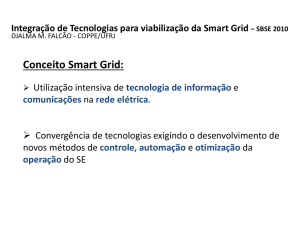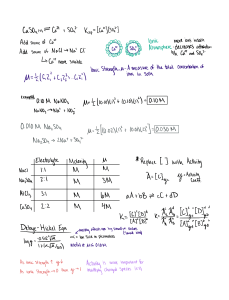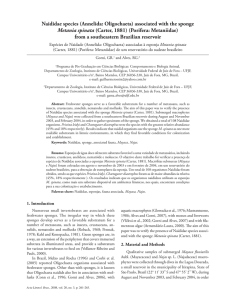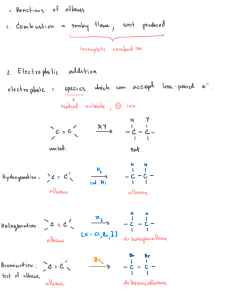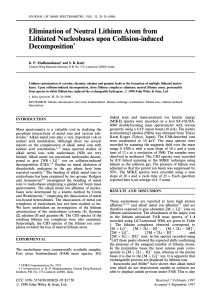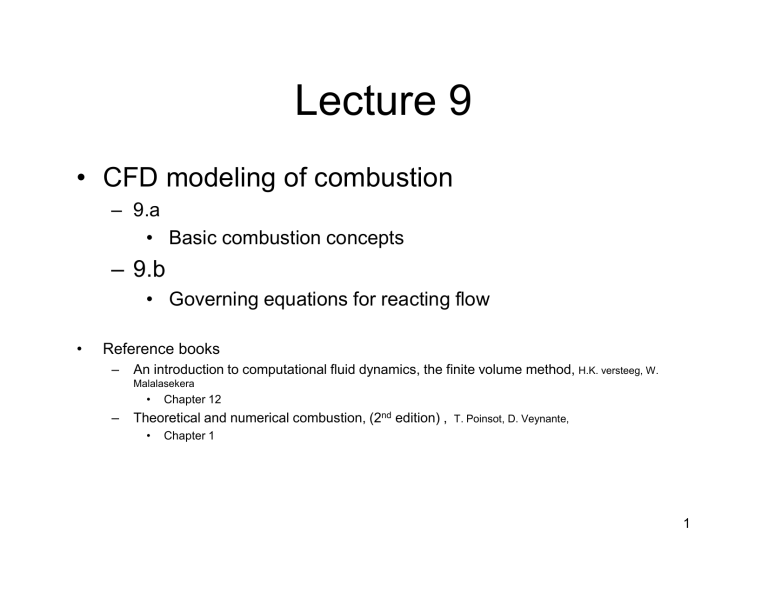
Lecture 9
• CFD modeling of combustion
– 9.a
• Basic combustion concepts
– 9.b
• Governing equations for reacting flow
•
Reference books
–
An introduction to computational fluid dynamics, the finite volume method, H.K. versteeg, W.
Malalasekera
•
–
Chapter 12
Theoretical and numerical combustion, (2nd edition) ,
•
T. Poinsot, D. Veynante,
Chapter 1
1
A few examples of combustion
Keywords:
Fire, power, Heat, light, color, emission, pollution,
Chemical reactions, multi-component mixture, radicals,
Flame, combustion acoustic, unstable combustion, detonation, etc.
2
Combustions
Combustion usually takes place in gas-phase,
through certain exothermic chemical reaction a cold
fuel/oxidizer mixture is turned into a hot product
mixture, a sustained combustion process happen in
a non-stationary flow environment which heats up a
continuous supply of freshly mixed fuel and oxidizer
gases.
fuel oxidizer
products
heat
>0
Physical conservation laws:
Conservation of mass (for each atom element)
Conservation of momentum (|| > 0).
Conservation of energy.
(Heat, mechanical work, kinetic energy, etc.)
A first observation:
A reacting flow domain can be regarded
as a multi-component gas “mixture”
composed of different species.
3
Relevant concepts to describe a muti-component gas mixture
:
+
1
2
→ 3
+
4
How much percentage a certain species of is inside a mixture?
Mole (number) fraction:
→ ∑ , >> 1
Mass fraction: → ∑
: mean molecular weight of the mixture
: mole weight for species k
: density of mixture
: for species k
: pressure of mixture
: for species
: specific Heat capacity at constant volume for mixture
, for species
: specific heat capacity at constant pressure for mixture
, for species
ℎ: Total Enthalpy of mixture
ℎ for species
ℎ : Sensible Enthalpy of mixture
ℎ, for species
Δℎ!" : Enthalpy of formation
"
Δℎ!,
for species
4
A combustion mixture contains multiple species () ≥ 1)
The mass fractions , the mole fractions
+ 2
Molecular weight for species :
∈[0, ,1,]
→ :
∈[0, ,1,]
@
= [X56 ,
=
A
@
/>
=
Mass fraction for species : Mixture-averaged mean
molecular weight
+ 2
= [12 + 6, 12 × 2, 12 + 16 × 2, 1 × 2 + 16] gram/mole
?
=
/>
?
= ∈ (1, … . , ))
= [89 , 7 , 87 , 9 7 ]
Mole fraction for species
for each species
∈[0, ,1,]
@
A
7
,
87
,
9 7]
@
>
=1
A A
= [Y56 , 7 , 87 , 9
@
= 1/ >
=>
7]
@
> = 1
5
Total pressure, partial pressure, Equation of state
for a mixture containing multiple species
@
Total pressure:
= >
=
CD
≡ E0
Partial pressure and
equation of state for a
single species
@
0 B = 0 CD
…
B = CD
…
@ B = @ CD
@
> B = > CD
E0
Equation of state
for the mixture
E0
∑@E0 =
CD = CD/
B
@
Mean molecular weight
∈ (1, … . , ))
= 1/ >
C: universal gas const.
=
6
Thermodynamics: Enthalpy and internal energy in a single-species system
First law of thermodynamics (conservation of energy)
(uvwZ × xyz{|Z) vw (
internal energy ]^_` bcd
⏞ − ⏞
Δ⏞
Z
= \
Internal energy:
energy e
(i) “Sensible” energy (averaged “kinetic energy”
uvwZ
× Bv~}Z)
}
of the random moving moleculars)
(ii) “chemical, or formation” energy stored in chemicalchemical-bonds
Enthapy h= Z + B: At constant pressure system (Volume change)
q`]_rs
Δ⏞
ℎ
bcd
t
= Δ Z + Δ B → Δ Z + pΔB
constant pressure
7
Total enthalpy, sensible enthalpy and enthalpy of formation
for a specie
ℎ : Enthalpy [ ] of a species (k) with respect to reference enthalpy at standard
conditions at pressure (1ATM) and temperature (D" =298.15K)
Total = sensible +chemical
ℎ =
ℎ,
"
+ Δℎ!,
"
= , xD + Δℎ!,
Sensible enthalpy: ℎ,
chemical , enthalpy of formation ( ),
, : specific heat capacity at constant pressure for species k
"
Enthalpy of formation Δℎ!,
: increase in enthalpy when a compound is
formed from its constitute elements in their nature forms at standard
conditions, for H2, O2 , N2, C (graphite) it is zero, for it is -393 520
KJ/kmol, because the exothermic reaction(heat release):
(w|ℎy{Z) + Æ
8
Sensible energy and chemical energy for a single specie
Sensible+chemical energy
Z = ℎ −
= ℎ,
=
=
−
,
Z,
"
+ Δℎ!,
CD"
"
xD −
+ Δℎ!,
Sensible
energy Z,
"
+ Δℎ!,
Chemical, enthalpy
of formation ( )
, : specific heat capacity at constant volume for species
9
Enthalpy and Energy in a multi-component mixture
Enthalpy of Mixture:
ℎ = ∑@E0 ℎ = ∑ =
=
∑
,
"
xD + Δℎ!,
"
, xD + ∑ Δℎ!,
"
xD + ∑ Δℎ!,
Enthalpy of formation for mixture
Energy of Mixture:
Z = ∑@E0 Z = ∑ =
=
∑
,
"
xD − + Δℎ!,
, xD − CD" ∑
"
+ ∑ Δℎ!,
"
xD − CD" / + ∑ Δℎ!,
& : Mixture-averaged heat capacity at constant volume and pressure respectively
, & , : Heat capacities for a single spices
10
Relation between Energy and enthalpy
for a mulit-component mixture and for each single species
Z = ℎ −
@
@
Z = > Z = >
ℎ −
=ℎ−
11
Apply first law of thermodynamics to an adiabatic (0D) combustion problem
Assume homogenous (no spatial gradient), zero mean velocity, adibatic
Given Unburned (fresh) state D , ,with mass fraction = [Y56
, 7 , 87
, 9 7 ]
To find Burned (product) state D , with mass fraction = Y56
, 7 , 87
, 9
=
constant pressure
ℎ = ℎ
]
]
@
"
xD + > Δℎ!,
= xD
constant volume
=
Z =Z
xD −
CD"
^
@
?
@
"
+ > Δℎ!,
7
?
@
"
"
+ > Δℎ!,
= xD − CD" / + > Δℎ!,
= / CD
^
12
Example: Assume a global, single-step, irreversible reaction,
determine the final burned mass fraction
mass fraction of unburned state
, 7 , 87
, 9 7 ]
Given = [Y56
Reactions conserve atomic elements
Left
coeff
( )
(1)
(2)
(3)
′
1
2
0
0
(4)
∗
Right
coeff
′′
1 ⋅ + 2 ⋅
1Δ ∶
2Δ
= [X56
,
⇒1⋅
⇒ 1Δ
= ( AA − A ) ⋅ Δ
0
0
∗
1
2
∑@E0 = 1 + ∑@E0 ≠ 1 ,
∗
normalize to get mole
fraction of burned state
mole fraction of unburned state
=
=
∗
∑@? E0
∗
?
,
9 7]
Assumption: either fuel or oxidizer
must be completely consumed.
Δ = min(
+
1 + ∑@? E0
87
,
+2⋅
∶ 2Δ
+
=
7
?
0
89 ,
7
)
mole fraction of burned state!
13
Some basic concepts relevant for combustion chemical reactions
Chemical reactions
The reaction mechanism
Globally reduced reaction
Stoichiometry/ Equivalence ratio
Detailed reaction mechanism
Elementary reactions
Unimolecular, Bimolecular and Termolecular
Reaction pathway
Intermediate species
Reversible reactions and chemical equilibrium
Finite rate of chemical reaction
Reaction rate constant
Arrhenius law
Activation energy.
14
The globally reduced single-step chemical reaction system
Different ways of preparing the reactant-mixture
1 ⋅ + 2 ⋅ (
1 ⋅ + 2 ⋅ (
1 ⋅ + 3 (
)
¡d
+3.76) )
¡d
+3.76) )
¡d
⇒1⋅
+2⋅
⇒1⋅
stoichiometry
+2⋅
stoichiometry
+ 2 ⋅ 3.76)
⇒1⋅
+2⋅
+ 2 ⋅ 3.76) + 1 (
1 ⋅ + 3 (
+3.76) )
⇒1⋅
+2⋅
+ 3 ⋅ 3.76) + 1 ⋅
1 ⋅ + 3 (
+3.76) ) + ⇒2⋅
+2⋅
+ 3 ⋅ 3.76) + 1 ⋅
1
1 ⋅ + (
2
+3.76) )
1
⇒ 4
( )
(1)
(2)
(3)
(4)
(5))
(6) Air
Left
′
1
0
0
0
¡d
¡d
Right
′′
¾
0
¼
½
0
3.76/2
½
0
( )
(1)
(2)
(3)
1
+ 2
Left
′
′′
0
¼
0
(5))
3.76/2
3
+ 4
Right
¾
(4)
+3.76) )
1
+ ⋅ 3.76)
2
1
½
¡d
0
½
3.76/2
Conservation
of each element:
> ′ }
[8]
[5, 6,,]
= > ′′ }
[5, 6,,]
} : number of a element [C] contained
within the molecular of species
15
Lets examine a global, single-step, fuel+oxidizer reaction system
Stoichiometry and equivalence ratio
1 ⋅ + 3 ⋅ (
+3.76) ) ⇒ 1 ⋅ ¡d
¥^r
t + 2 ( +3.76) ) ⇒ 1 ⋅ 1 ⋅ 1Δ ∶
2Δ
∶ 1Δ
¥^r
7¨¡©¡ª^d
¥^r
7¨¡©¡ª^d
+2⋅
+2⋅
∶
2Δ
+ 2 ⋅ 3.76) + 1 ⋅ (
+ 2 ⋅ 3.76)
∶ 2 ⋅ 3.76Δ
′¥^r
1
=
′7¨¡©¡ª^d 2
`
1 ⋅ 89
′¥^r ⋅ ¥^r
=
=
′7¨¡©¡ª^d ⋅ 7¨¡©¡ª^d 2(W¬ + 3.76W@¬ )
`
+ 3.76) )
No fuel or oxidizer coexist
on the product side
=
Equivalence ratio:
1 ⋅ + 3 ⋅ (
­=
®¯°
±²³´³µ¯¶ _·`_r
/
®¯°
±²³´³µ¯¶ `
Both fuel and oxidizer are
completely consumed!
Δ|¦§ =
0
=
89
¡d
z{
­ > 1: ¸Z~ wyℎ
­ < 1: ¸Z~ ~Z|
­ = 1: º{vyℎyv}Z{w»
1 ⋅ ¥^r 1 ⋅ ¥^r 2
+3.76) )
­=
/
= < 1:
3 ⋅ ¡d 2 ⋅ ¡d
3
¸Z~ ~Z|
16
Estimation of adiabatic flame temperature
If a fuel/oxidizer mixture is burned completely (assume under constant pressure), and if no external heat
or work transfer takes place , then all energy liberated by chemical reaction will heat the product,
achieving max (adiabatic ) flame temperature!
stoichiometry
( )
(1)
(2)
(3)
(4)
(5))
1 ⋅ + 2 ⋅ ( +3.76) ) ⇒ 1 ⋅ 1Δ ∶ 2Δ ∶ 2 ⋅ 3.76Δ ∶ 1Δ
Left ′
Right
1
0
2
0
0
2 ⋅ 3.76
→
Reaction
→
1
2
D
Δ = mi(
→
0
89 ,
¡d )
= ( AA − A ) ⋅ Δ
∗
∗
2 ⋅ 3.76
+ 2 ⋅ 3.76)
∶ 2 ⋅ 3.76Δ
∈ [Y56
, 7 , @ , 87
= 0, 9 7 = 0]
′′
0
+2⋅
∶
2Δ
=
+
normalize→
Note: for non-stoichiometry mixture (i.e. ­ ≠ 1), the product mixture
≠ 0 or c¨¡©¡ª^d
≠ 0)
may contain unburned fuel or oxidizer (i.e. !^r
@
"
xD + > Δℎ!,
= xD
@
"
+ > Δℎ!,
17
Chemical equilibrium and reverse reaction
In practice, some reactions occur in the reverse direction (more prominent at high temperature).
1
2
1
⇌ +
2
⇌+ ⇌+
…
⇌ +
Equilibrium maximize Gibbs function
Gibbs function [ ]:
=ℎ−D⋅z
specific entropy z:
⋅ ½
⋅ ¾ + ⋅ ¿ + · ⋅ + ⋯ ⇌ ^ ⋅ Á + ! ⋅ u + ⋯
Condition for equilibrium: ΔÂ" = −CD log Ã
Equilibriums constant.
à =
q ¥
Ä
^ ! …
…
=
.
.
.
_ · . .
8
18
Combustion: chemical reaction mechanism
Example of hydrogen oxidization
A globally reduced one-step reaction +
1
2
⇒
A detailed reaction mechanism contain multiple elementary reactions involving
many intermediate species
+
⇌2 + ⇌ +
+ ⇌ +
+ ⇌ +
+
⇌ +
+ ⇌ + + +Å⇌ +Å
….
, , , ,intermediate species (radicals), Å denotes third body ( or,
arbitrary atom/radical/molecures which increase the collision chance for
chemical reactions)
19
Detailed chemistry, Intermediate species
Another example for methane oxidization
20
Detailed chemistry, Intermediate species
Example for methane oxidization
A detailed GRI-mechanism(still not complete) contains 325 elementary
reactions, 53 species, which is optimized for certain ranges of
temperature and pressure conditions.
Different chemical
reaction “pathway”
or subsystem.
21
Chemical reaction does not happen in an instant, it takes time…
Elementary reactions and the reaction rate
[¾] :
Molecularity
Unimolecular
Bimolecular
Elementary Step
½
¾ → wvx{z
½
¾ + ¿ → wvx{z
½
¾ + ¾ → wvx{z
Termolecular
½
¾ + ¾ + ¿ → wvx{z
½
¾ + ¾ + ¾ → wvx{z
½
¾ + ¿ + → wvx{z
Ã0
¾+¾+¿ ⇌ +É
ÃÈ0
¾+¾+¿
+É
½ËÊ
½Ê
+É
¾+¾+¿
Æcr
ÆÇ
Rate Law for Elementary
step [ Æcr]
ÆÇ ⋅
w|{Z = Ã[¾]
w|{Z = Ã[¾][¿]
w|{Z = Ã ¾
w|{Z = Ã ¾ [¿]
w|{Z = Ã ¾
1
w|{Z = Ã[¾][¿][]
w|{Z = Ã0 ¾
¿
wate = ÃÈ0 [] É
Note: forward/backward reaction can also be related through equilibrium condition
22
Reaction rate constant and Arrhenius law
Reaction rate constant :
(Arrhenius law)
Ã()
Á_
Ì
= ¾D exp(− )
CD
à → 0 when D ≪ D_ ≡
à ≫ 0 when D ≫ D_
qÐ
¾: pre-exponential constant
Î : temperature exponent
Á_ : Activation energy.
Just a note: Ã has different unit for
different order of elementary reaction
Unimolecular , w|{Z = Ã[¾]
Bimolecular
,
..
w|{Z = Ã[¾][¿]
23
Determine the reaction rate of a specie Ò involved in multiple Ó elementary reactions
All elementary reactions (all rewritten as forward reaction)
All species
)
1: ¾
2: ¿
…
Ò: …
):…
1:
Û
…
½Ê
½¬
…
Ô: 1¾ + 0¿ + ⋯ + 2 + ⋯ … 0¾ + 1¿ + ⋯ + 0 + ⋯
…→…
Ó: 0¾ + 2¿ + ⋯ + 1 + ⋯
½Õ
…
2¾ + 0¿ + ⋯ + 0 + ⋯
…→…
Ö× Ø,Ù =
AA
A
(Ø,Ù
−Ø,Ù
)
Ú
¡
?
ݳ,Õ
Total mole concentration
Á_ Ù
ÌÕ
ÃÙ = ¾Ù D exp(−
)
CD
rate in mole
unit
Ö× Ø = >
rate in mass
unit
Þ× Ø = Ø ÖØ× , ∀ k = 1, … )
ÙE0
Ö× Ø,Ù
@
ÃÙ ∏¡E0
24
Governing equations describing temporal evolution for a
(homogenous, adiabatic, stationary) reacting mixture
∑ = 1
©
©`
= Þ× ,
= 1, … ) − 1
= CD/
+
Const. pressure
x
ℎ=0
x{
or
+
Constant volume
x
Z=0
x{
) + 2 Unknowns for the above ) + 2 equations:
à á = [ ({), D({), Æ { , = 1, … ) ]
Initial conditions:
à { " = [ ({ " ), D({ " ), Æ { " ,
= 1, … ) ]
The process of combustion chemical reaction can be viewed as a (nonlinear) dynamic system problem
Typical features in terms of trajectory and attractors for gas phase combustion system
A set of ÉÁ equations solved for D({), { , ({); k=1,..,N), starting at { = 0.
©
©` 0
©
©`
…
©
D
©`
= Þ0 (0 , , ..,,@ , , D)
= Þ (0 , , …, @ , , D)
= Þ (0 , ,…, @ , , D)
The solution to the ODEs is a trajectory in high dimensional
phase space spanned by N+2 unknowns variables.
A few simple algebraic constraints such as conservation of elements
and also total mass can reduce the number of unknowns.
26
Combustion chemical reaction can be viewed a (nonlinear) dynamic system problem
Typical features in terms of trajectory and attractors for gas phase combustion system
A sketch showing numerical time advancement from three
different initial state points
Assume a reduced combustion
system of only three unknowns, the
solution for this nonlinear ordinary
differential equations (ODES) are
trajectory moving in a 3D phase
space spanned by (0 , , 1).
©
Ö
©` 0
©
Ö
©`
©
Ö
©` 1
Ö1
= Þ0 (Ö0 , Ö , Ö1 )
Slowly approaching certain attracting
manifold formed by, for instance, hemical
equilibrium states
= Þ (Ö0 , Ö , Ö1 )
= Þ1 (Ö0 , Ö , Ö1 )
Þ ∼Ã
rapid state change due to large |Þ| cause by à D
after reaction liberated heat raising temperature
…
Ö
Catalyst “drill” a tunnel
Ö0
Initial slow incubation to prepare radical pools
and heat required for “activating” reaction
27
A note from chemistry
Certain (non-gas-phase-combustion) chemical reaction do not have to be
attracted to the equilibrium solution! Their attracting manifold may be a limitcycle or even chaotic orbit.
The Belousov-zhabotinsky reaction!
1
0
YouTube showing Belousov-zhabotinsky reaction!
https://www.youtube.com/watch?v=0Bt6RPP2ANI#t=00m34s
28
Note: there exist more complicate “attracting manifold” for other nonlinear dynamical system
Combustion equations
Complex phenomena exists in other
nonlinear dynamics system (Examples:
pendulum system, three-body problem, …)
©
Ö
©` 0
©
Ö
©`
©
Ö
©` 1
= Þ0 (Ö0 , Ö , Ö1 )
= Þ (Ö0 , Ö , Ö1 )
= Þ1 (Ö0 , Ö , Ö1 )
The famous 3D
“butterfly” trajectory with
“chaotic attractor” for
the Lorenze equations
29
Theoretic and numerical aspects for combustion chemical reaction
1) For most gas-phase combustion, there often exists fast and slow reactions, the time scales
of these reactions may differ in several order of magnitude. It is a mathematical “stiff”
system with significantly different time-scales, an expensive adaptive-time-step ODE solver
must be used to perform numerical time-integration.
1)
Such calculation will usually be performed by “popular” software package: such as Chemkin(free
before, not any more), Cantera (free) and Flamemaster … . Note, accurate calculation of
thermodynamic and transport coefficients (, , Δℎ", ,..ÉÙ, ) are usually based on the NASA
polynomials, the chemical kinetic mechanism including all elementary reactions and the reacting
constants can be downloaded together with a published journal article.
2) For common gas combustion reaction, there often exist certain “intrinsic lower-dimentional
manifolds” (ILDM) in the phase space, towards which a trajectory will be quickly attracted.
When the trajectory come close to the vicinity of such “manifold” region, the solution along
trajectory then stay parallel and move slowly within such “manifold”.
3) Very expensive calculations of stiff-ODE solver for every CFD-cells.
Ideal: Tabulation
The In-situ adaptive-tabulation (ISAT), by S.B. Pope.
30
CFD modeling of combustion
Governing equations for reacting flow
31
Governing equation for reacting flow
Combustion does not create
new mass, it just redistributes
mass among different species.
Global Mass
Momentum
Burning liberated heat
causes flow dilatation
å å¡
+
=0
åæ¡
å{
å¡
1 å
å
=−
+ ¡
≠0
åæ¡
åæ¡
å{
@
å åç¡Ù
å¡ å¡ Ù
+
=−
+
+> ¸
åæÙ
åæ¡ åæÙ
å{
E0
é
Typical combustion causes
ê
ê
éÕ
,Ù
é
ç¡Ù = è(é¨ ³ + é¨ ) − 1 ¡Ù é¨
=
¶ë
Õ
³
= 5 vw 10 large variation in
dynamic viscosity è(D) and large dilatation term
32
Conservation of species mass
å(Ù +B ,Ù )
å
+
= Þ× ,
å{
åæÙ
Mass conservation
for species k
>
Gobla mass eq.
= 1, … , )
åÙ å
å
+
=−
(B ,Ù ) + Þ× ,
å{
åæÙ
åæÙ
åÙ ∑ å ∑ å
+
=−
∑B ,Ù å{
åæÙ
åæÙ
å ⋅ 1 å¡ ⋅ 1
+
=
å{
åæ¡
∑ = 1
0
∑B ,Ù = 0
= 1, … , )
B ,Ù : the diffusion
velocity
+ > Þ×
+ 0
∑Þ× = 0
33
Compute the diffusion velocity B
An less accurate simple gradient model (Fick law )
Fick law
B ,Ù =−É
é
é¨Õ
> Æ violate: ∑B ,Ù = 0
å(Ù +îïðññ
)
å
å
Ó
+
=−
(B ,Ù ) + Þ× ,
å{
åæÙ
åæÙ
|¥¡· =∑É
îïðññ
Ó
In a simple condition when
we assume const É for all
species, i.e.
É0 = ⋯ = DØ … = D,
B ,Ù = É
îïðññ
ò
Ó
¥¡·
å
åæÙ
é
é¨Õ
=0
= 1, … , )
Note: some CFD code does not
use this strategy of correctionvelocity, the inconsistence error
is then pumped into certain
abundant diluting gas such as N2
34
Compute the diffusion velocity B
Solve the more accurate full equations
mole
ó
Æ
= ∑
ôõ ô
öõ
ÉÆ = É
Æ
B − BÆ + Æ −
÷ø
Æ ù
ê
+ ∑ Æ ¸Æ − ¸ , for } = 1, . . )
is binary mass diffusion of species } diffuse into ,
= /
is the mole fraction of ,
Neglect Soret effect (mass diffusion due to temperature gradient) .
35
Diffusion velocity B
Binary diffusion in a two-species system 0 + = 1 :
Assume: |ó| is mall, neglect volume force:
ó
Æ
= ∑
ôõ ô
öõ
B − BÆ + Æ −
÷ø
Æ ù
ê
+ ∑ Æ ¸ − ¸ , for } = 1, . . )
Binary diffusion:
ó
0
=
0
É0
B0 − B
∑B = B0 0 + B = 0
B0 0 = −É0 ó0
= /
Fick law is exact for binary diffusion
36
Diffusion velocity B
Multi-species diffusion: Hirschfelder-Curtiss approximation
ó
Æ
= ∑
ôõ ô
öõ
÷ø
Æ ù
B − BÆ + Æ −
ê
+ ∑ Æ ¸ − ¸ , for } = 1, . . )
Multi-species diffusion:
A complicated inversion problem, Hirschfelder-Curtiss approximation is a
best first-order approximation of exact system.
not Fick law anymore
B
= −ÉØ ó
B = −ÉØ ó
= /
É ≠ ÉÙ species
into the "mixture"
diffuse
0È
Õú ôÕ /öÕ
É = ∑
37
Species mass equations with different models of diffusion velocity
B
Hirschfelder-Curtiss
approx. (more accurate)
= −ÉØ ó
= /
B = −ÉØ
ó
å(Ù + BÙ·cdd |98 )
å
å
å
+
=−
(É
) + Þ× ,
åæÙ
åæÙ
åæ
å{
Ù
BÙ·cdd ò
98
= ∑É
= 1, … , Ã
å
åæÙ
Fick approx. (not accurate, but easy for numerical implementation)
å ∑ å{
å(Ù + BÙ·cdd |¥¡· ) ∑ å
å
+
=−
É
+ > Þ×
åæÙ
åæÙ
åæÙ
38
Various definition of Energy and enthalpy
0
Kinetic energy : ¡ ¡
"
Chemical energy: ∑@E0 Δℎ!,
"
, ℎ!,
enthalpy of formation
39
Derive the kinetic energy equation from mass and momentum eq.s
Useful indentiy: material-derivative
1
1
å ¡
å ¡
2
+ Ù 2
å{
åæÙ
Ê
éê ³¬
¬
é`
éý
é`
é
+ Ù é¨ ­ =
å¡
å¡
å åç¡Ù
+ Ù
= −
+
+ ∑ ¸
å{
åæÙ
åæ¡ åæÙ
¡ ×
1
2 ¡
öý
ö` ≡ ×
+
å åÙ
+
å{
åæÙ
Ê
éêÕ ³¬
¬
é¨Õ
= ¡ −
+
≡
Ê
,Ù
å åç¡Ù
+
+ ∑ ¸
åæ¡ åæÙ
é
+ é¨ Ù ­
Õ
Momentum eq.
,Ù
û¡Ù = ç¡Ù − ¡Ù
=0
ö ³¬
¬
ö`
Õ
éêý
é`
= ¡ (
éü³Õ
é¨Õ
+ ∑ ¸ ,Ù )
viscous-stress contributes to “reversible” mechanical work!
40
Energy equation
for total energy (sensible + chemisical-bond+ kinetic energy)
Useful indentiy: material-derivative
Total energy Z`
éý
é`
é
+ Ù é¨ ­ =
Õ
éêý
é`
é
+ é¨ Ù ­
Õ
åÖÙ
ÉZ`
å
=−
+
û¡Ù ¡ + \× + > ¸ ,Ù (Ù + B ,Ù )
É{
åæÙ åæÙ
åD
ÖÙ = −þ
+ >ℎ B
åæÙ
Fourier’s
law
öý
ö` ≡ ,Ù
û¡Ù = ç¡Ù − ¡Ù
Diffusion of multispecies with
different enthalpy
\:× external
heat source
(not burning
released heat)
∑ ¸ ,Ù (Ù + B ,Ù ) ,
power produced by
volume force.
Buoyance, etc. 41
Energy equation
for total enthalpy (sensible + chemistry+ kinetic energy)
Total Enthalpy: ℎ` =Z` + /
ÉZ`
Éℎ` É
å¡
=
−
−
É{
É{
É{
åæ¡
åÖÙ
ÉZ`
å
=−
+
û + \× + > ¸ ,Ù (Ù + B ,Ù )
É{
åæÙ åæÙ ¡Ù ¡
åÖÙ
å
Éℎ` É
å¡
−
−
=−
+
û¡Ù ¡ + \× + > ¸ ,Ù (Ù + B ,Ù )
É{
É{
åæ¡
åæÙ åæÙ
û¡Ù = ç¡Ù − ¡Ù
Éℎ` å åÖÙ
å
=
−
+
ç¡Ù ¡ + \× + > ¸ ,Ù (Ù + B ,Ù )
É{
å{
åæÙ åæÙ
42
Energy equation
for enthalpy (sensible + chemistry+ kinetic energy)
0
Enthalpy: ℎ=ℎ` − ¡
Éℎ` å åÖÙ
å
=
−
+
ç¡Ù ¡ + \× + > ¸ ,Ù (Ù + B ,Ù )
É{
å{
åæÙ åæÙ
1
É ¡
å åç¡Ù
2
= ¡ −
+
+ ∑ ¸
É{
åæ¡ åæÙ
,¡
Éℎ É åÖÙ
å¡
=
−
+ ç¡Ù
+ \× + > ¸ ,Ù B
É{
É{
åæÙ
åæÙ
,Ù
43
Energy equation
for sensible enthalpy (sensible + chemistry+ kinetic energy)
"
Sensible Enthalpy: ℎ = ℎ − ∑@ Δℎ!,
Éℎ É
å¡ åÖÙ
=
+ ç¡Ù
−
É{
É{
åæÙ åæÙ
"
> Δℎ!,
×
É
=
É{
+ \× + > ¸ ,Ù B
å
−
B ,Ù åæÙ
åD
ÖÙ = −þ
+ >ℎ B
åæÙ
,Ù
= 1, … , )
Éℎ É
å¡ åÖÙ
å
"
=
+ ç¡Ù
−
+
> Δℎ!,
B
É{
É{
åæÙ åæÙ åæÙ
+ Þ× ,
,Ù
"
− > Δℎ!,
Þ× + \× + > ¸ ,Ù B
"
ℎ, = ℎ − Δℎ!,
å¡
Éℎ É
å
åD
å
=
+ ç¡Ù
+
þ
−
> ℎ, B
É{
É{
åæÙ åæÙ
åæÙ
åæÙ
,Ù
"
− > Δℎ!,
Þ× + \× + > ¸ ,Ù B44
,Ù
,Ù
,Ù
Energy equation
in temperature form
≡ > (æ, {),
ÉD
Éℎ
ࡰࢅÒ
= + > ࢎ࢙,Ò ࣋
É{
ࡰá
É{
Ò
> ࢎ࢙,Ò ×
,Ù
-
É
=
É{
−
å
B ,Ù åæÙ
"
− > Δℎ!,
Þ× + \× + > ¸ ,Ù B
,Ù
+ Þ×
(࢞,`)
ℎ, ≡ , xD A
ℎ ≡ xD A
Éℎ É
å¡
å
åD
å
=
+ ç¡Ù
+
þ
−
> ℎ, B
É{
É{
åæÙ åæÙ
åæÙ
åæÙ
[࢞,`]
"
ℎ = ℎ, + Δℎ!,
ÉD É
å¡
å
åD
=
+ ç¡Ù
+
þ
− > , B
É{
É{
åæÙ åæÙ åæÙ
,Ù
åD
− > ℎ Þ× + \× + > ¸ ,Ù B
åæÙ
45
,Ù
Various form of energy eq.
46
Summary of reacting flow equations
assume no body force, no external heating
å å¡
+
=0
å{
åæ¡
Global Mass
åÙ å
å
+
=−
B ,Ù å{
åæÙ
åæÙ
Species
conservation
Momentum
either
Energy
or
+ Þ× ,
= 1, … , ) − 1
å åç¡Ù
å¡ å¡ Ù
+
=−
+
åæÙ
åæ¡ åæÙ
å{
Éℎ` å åÖÙ
å
=
−
+
ç É{
å{
åæÙ åæÙ ¡Ù ¡
ÉD É
å
åD
=
+
þ
− > , B
É{
É{ åæÙ
åæÙ
,Ù
åD
å¡
"
+ ç¡Ù
− > Δℎ!,
Þ×
åæÙ
åæÙ
47
Simplification for the reacting flow governing equations
• Low Mach number assumption
– ({, ࢞) = ({) + ′({, ࢞) and |pA | ≪ ||
•
“Thermodynamic” pressue + “hydrodynamic” pressure
• Transport coeff. ( such as Heat capacity )
– Equal (among k) for all species
– Const (t) for mixture
• Non-dimentional number.
– Lewis number (the ratio of thermal diffusivity to mass diffusivity. )
– Schmidt number (the ratio of momentum diffusivity (kinematic viscosity) and
mass diffusivity )
– Prandtl number (ratio of momentum diffusivity to thermal diffusivity)
48
Let’s consider a simple reacting system involving only two
species and a single step reaction
Mass fraction of:
Product: Fuel : 1 − Fuel → Product
(e.g. 3
→2
1
)
Assumption:
(1) 1D
(2) Equal molecular weight: !^r = dc© = → ୮ = )
"
"
(3) Δℎ!^r
= 0, Δℎdc©
< 0 (heat release, exothermal reaction)
(4) Constant thermodynamic/transport properties for fuel/product and perfect ideal gas,
heat capacity: , mass diffusivity: É! = É = É0 (to be used later)
(more)
"
+ Δℎ!,
2
ℎ` = Z` +
∗
p = C D; − = C∗
Z` = D +
49
Obtain the reduced equations for a simplified reacting flow system
(1) the species-mass equation
å(Ù +îïðññ
)
å
å
Ó
+
=−
B ,Ù åæÙ
åæÙ
å{
3DÆ1D
+ Þ×
Fick law
ÉA ≡ É
å
å
å å
+
=−
ÉA + Þ× dc© ,
åæ
åæ
åæ
å{
,
= 1, … , )
Only two species
= 1,2
Assume const.
50
Obtain the reduced equations for a simplified reacting flow system
(2) the momentum equation:
@
å åç¡Ù
å¡ å¡ Ù
+
=−
+
+> ¸
åæÙ
åæ¡ åæÙ
å{
E0
,Ù
é
éÕ
é
ç¡Ù = è(é¨ ³ + é¨ ) − 1 ¡Ù é¨
3DÆ1D
Õ
³
å å( + )
å
å
+
=
è′ å{
åæ
åæ
åæ
4
è′ ≡ è
3
Assume const.
51
Obtain the reduced equations for a simplified reacting flow system
(3) energy equation:
Assume þ const.
Neglect viscous heating
Éℎ` å åÖÙ
å
=
−
+
ç¡Ù ¡ + \× + > ¸ ,Ù (Ù + B ,Ù )
É{
å{
åæÙ åæÙ
Compressible
(Conservative form)
å
å
å
å
Z +
ℎ` =
þ D
å{ ` åæ
åæ åæ
∑B ,Ù = 0
ÉD É
å
åD
=
+
þ
− > , B
É{
É{ åæÙ
åæÙ
Low Mach number assumption:
(æ, {) = ({) + A (æ, {), |A | ≪ ||
Non-conservative form:
,Ù
åD
å¡
"
+ ç¡Ù
− > Δℎ!,
Þ×
åæÙ
åæÙ
ÉD å
å
åD
"
=
+
þ
− Δℎ!,dc©
Þ× dc©
É{
å{ åæÙ
åæÙ
52
The simplified 1D reacting system
Summary for the compressible reacting flow governing equations
Mass fraction of:
Product: Fuel : 1 − Fuel → Product
Conservation laws:
å å
å Specie mass:
+
= É′
+ Þ× dc©
“product”
å{
åæ
åæ
å å
+
=0
Total mass:
å{
åæ
å
å
å +
+ = èA
Momentum: å{
åæ
åæ
å
å D
å
Z +
ℎ` = þ
åæ
å{ ` åæ
Energy:
Equation of state
= C∗ D
Arrhenius reaction
Þ× dc©
1
È Ð
= (1 − ) Z
ç·
"
Z` = D +
+ Δℎ!,
2
ℎ` = Z` +
− = C∗
(Note: if diffusion, viscous and heat-conduction terms are neglected, the system is
governed by a hyperbolic four-waves equations, all equations are in conservative
form except an non-zero source term in the first species-mass equation) 53
The simplified 1D reacting system
Summary of governing equations under low Mach assumption
Mass fraction of:
Product: Fuel : 1 − Fuel → Product
Arrhenius reaction
Conservation law for:
Specie mass:
“product”
total mass:
Momentum:
Energy:
å å
å +
= É′
+ Þ× dc©
å{
åæ
åæ
å å
+
=0
å{
åæ
å
å å
+
+ ′ = è′
åæ
åæ
å{
Þ× dc©
1
È Ð
= (1 − ) Z
ç·
ÉD å
åD
å
"
=
+
þ
− Δℎ!,dc©
Þ× dc©
É{
åæÙ
å{ åæÙ
Low Mach assumption:
{ = {, æ C∗ D({, æ) ,
A (æ, {) ≠ ({)
54

